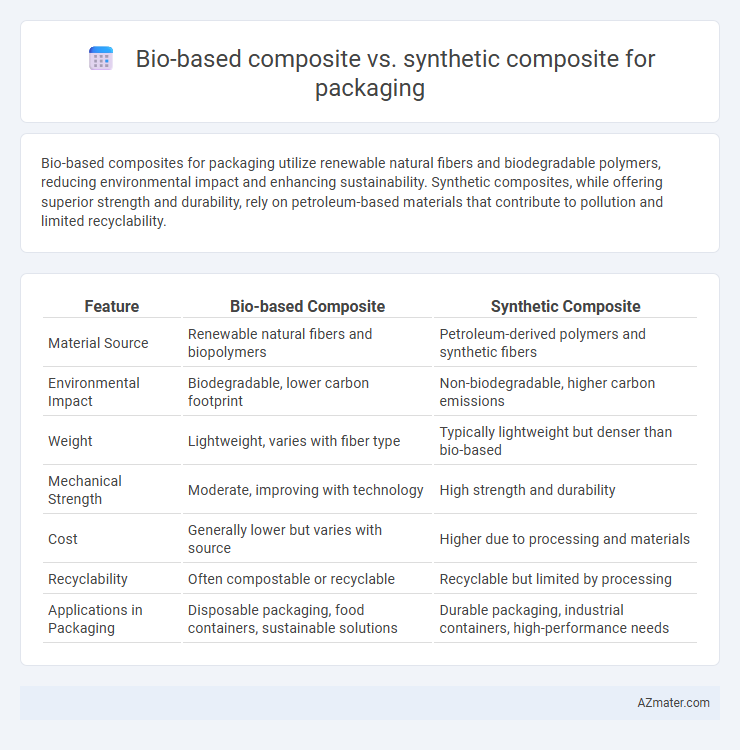Bio-based composites for packaging utilize renewable natural fibers and biodegradable polymers, reducing environmental impact and enhancing sustainability. Synthetic composites, while offering superior strength and durability, rely on petroleum-based materials that contribute to pollution and limited recyclability.
Table of Comparison
| Feature | Bio-based Composite | Synthetic Composite |
|---|---|---|
| Material Source | Renewable natural fibers and biopolymers | Petroleum-derived polymers and synthetic fibers |
| Environmental Impact | Biodegradable, lower carbon footprint | Non-biodegradable, higher carbon emissions |
| Weight | Lightweight, varies with fiber type | Typically lightweight but denser than bio-based |
| Mechanical Strength | Moderate, improving with technology | High strength and durability |
| Cost | Generally lower but varies with source | Higher due to processing and materials |
| Recyclability | Often compostable or recyclable | Recyclable but limited by processing |
| Applications in Packaging | Disposable packaging, food containers, sustainable solutions | Durable packaging, industrial containers, high-performance needs |
Introduction to Bio-based and Synthetic Composites
Bio-based composites for packaging combine natural fibers such as hemp, flax, or cellulose with biodegradable polymers, offering renewable, eco-friendly alternatives to traditional materials. Synthetic composites typically use petroleum-derived polymers and reinforcement fibers like fiberglass or carbon fiber, providing superior strength and durability but with higher environmental impact. The choice between bio-based and synthetic composites hinges on balancing sustainability goals with performance requirements in packaging applications.
Composition and Material Sources
Bio-based composites for packaging typically consist of natural fibers such as hemp, flax, or cellulose combined with biodegradable polymers derived from renewable resources like polylactic acid (PLA) or starch-based resins, emphasizing sustainability and reduced environmental impact. Synthetic composites rely on petrochemical-based materials such as fiberglass or carbon fiber reinforced with thermoset or thermoplastic resins like epoxy or polypropylene, offering superior strength and durability but posing challenges in recyclability and biodegradability. Material sourcing for bio-based composites prioritizes renewable, agricultural, or forestry by-products, whereas synthetic composites depend heavily on non-renewable fossil fuels and chemical manufacturing processes.
Environmental Impact and Sustainability
Bio-based composites for packaging utilize renewable resources such as plant fibers and biopolymers, significantly reducing carbon footprint and reliance on fossil fuels compared to synthetic composites derived from petroleum-based materials. The biodegradability and compostability of bio-based composites enhance waste management and minimize environmental pollution, contrasting with synthetic composites that often persist in ecosystems and contribute to microplastic contamination. Sustainability assessments demonstrate that bio-based composites offer a lower environmental impact throughout their life cycle, supporting circular economy principles and reducing greenhouse gas emissions in packaging applications.
Mechanical Strength and Performance
Bio-based composites for packaging offer comparable tensile strength and impact resistance to synthetic composites while providing improved biodegradability and environmental sustainability. Mechanical performance of bio-based composites varies with fiber type and matrix composition but often achieves sufficient durability for most packaging applications. Synthetic composites typically excel in consistent mechanical strength and moisture resistance, making them suitable for heavy-duty packaging requiring prolonged durability.
Barrier Properties for Packaging
Bio-based composites for packaging offer improved environmental sustainability with moderate barrier properties against moisture and gases, making them suitable for short-term food packaging. Synthetic composites, such as those made from polyethylene or polypropylene, provide superior barrier performance against oxygen, carbon dioxide, and water vapor, ensuring longer shelf life and product protection. Advances in bio-based nanomaterials, like cellulose nanocrystals, are enhancing the barrier efficiency of bio-based composites, closing the gap with traditional synthetic options.
Cost-effectiveness and Market Availability
Bio-based composites typically offer lower raw material costs due to renewable sources but may involve higher processing expenses compared to synthetic composites, which benefit from established manufacturing infrastructure. Synthetic composites dominate market availability with widespread commercial adoption and consistent supply chains, while bio-based composites are expanding niche markets driven by sustainability demands but face limited scale and higher unit costs. Cost-effectiveness analysis must balance initial material expenses, lifecycle environmental benefits, and evolving consumer preferences influencing demand for bio-based packaging.
Biodegradability and End-of-Life Scenarios
Bio-based composites offer superior biodegradability compared to synthetic composites, breaking down naturally under composting conditions within months, reducing landfill burden and microplastic pollution. In end-of-life scenarios, bio-based composites can be composted or incinerated with lower toxic emissions, whereas synthetic composites often persist for decades and generate harmful residues when incinerated or landfilled. Preference for bio-based composites in packaging improves sustainability by facilitating circular economy practices and minimizing environmental impact.
Regulatory Compliance and Safety
Bio-based composites for packaging often benefit from regulatory frameworks favoring renewable materials, conforming to standards such as ASTM D6866 for biobased content and EU's REACH regulation on chemical safety. Synthetic composites, while durable, require rigorous testing under FDA and EU packaging directives to ensure absence of harmful substances like BPA or phthalates. Both materials demand compliance with global safety standards like ISO 22000 for food contact applications, but bio-based options offer enhanced eco-labeling opportunities under certifications like USDA BioPreferred.
Consumer Perception and Market Trends
Bio-based composites in packaging are increasingly favored by environmentally conscious consumers seeking sustainable and biodegradable alternatives to synthetic composites. Market trends reveal a rising demand for bio-based materials driven by regulatory pressures and growing awareness of plastic pollution, pushing brands to adopt eco-friendly packaging solutions. Consumer perception highlights a preference for natural, non-toxic ingredients in packaging, positioning bio-based composites as a key growth sector in sustainable packaging markets.
Future Prospects in Packaging Innovations
Bio-based composites offer sustainable advantages with biodegradability and reduced carbon footprint, driving their integration in eco-friendly packaging solutions. Synthetic composites continue to evolve with enhanced durability and lightweight properties, supporting high-performance packaging in demanding environments. Future packaging innovations will likely blend bio-based materials with synthetic composites, optimizing functionality while prioritizing environmental impact.

Infographic: Bio-based composite vs Synthetic composite for Packaging
 azmater.com
azmater.com